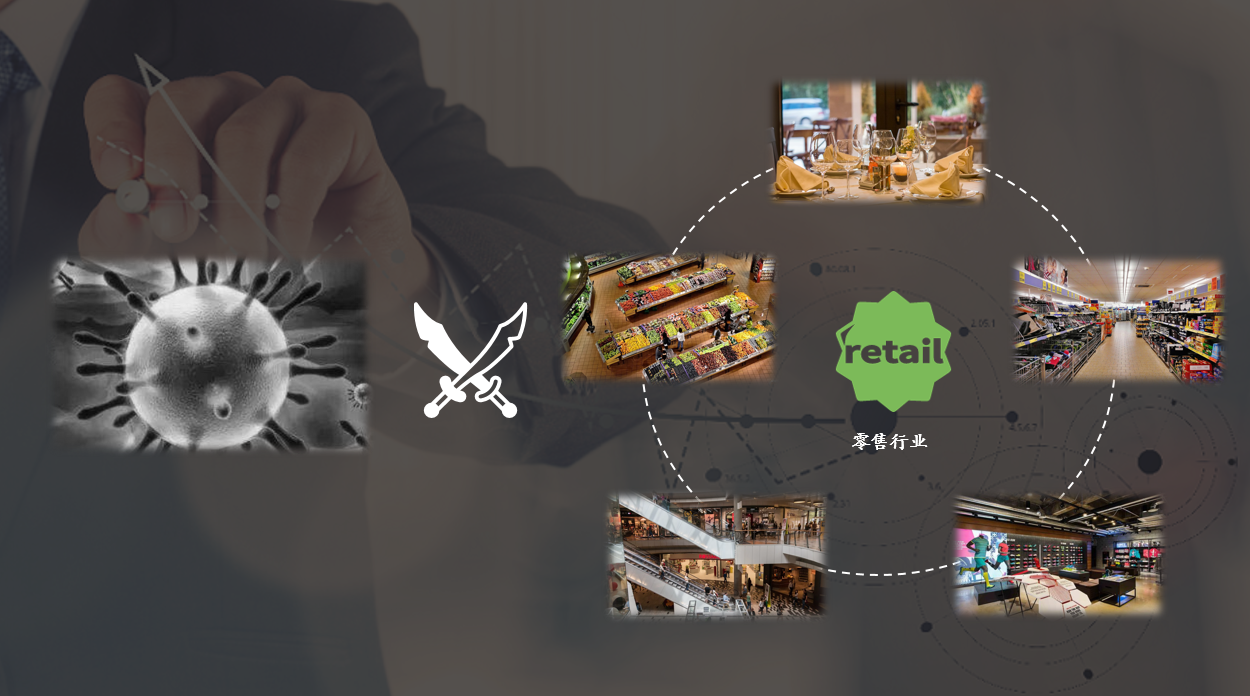Tips on supply chains to help the retail industry overcome difficulties


Hi, everyone, I am Zhang Jiexi, a partner of Deloitte Consulting LLP. My focus is on supply chain management in the consumer goods and the retail industry. Today, at the first session of the Deloitte College’s “Response to the Pandemic” supply chain management series, I'd like to share with you the topic of tips on supply chain to help the retail industry overcome difficulties.
As we all know, the outbreak of COVID-19 during the Spring Festival of the Year of the Rat has had a major impact on all walks of life, and the retail industry closest to consumers has borne the brunt. Therefore, how to correctly recognize the challenges exposed to business operations by the pandemic, and how to take effective supply chain measures to ensure business operations during the special period and turn crisis into opportunities will become topics that supermarkets, restaurants and other retail enterprises need to seriously consider.
In this micro-class, I will elaborate on four aspects.
First, the pandemic has had a major impact on the retail industry.
Ⅰ,For the retail industry, the most significant impact of the pandemic in the short term is manifested in three aspects:
- offline physical stores are forced to adjust their business hours or are even temporarily closed, resulting in a precipitous decline in store sales. For example, Apple temporarily closed all stores nationwide; Starbucks suspended all stores and delivery service in Hubei Province, as well as more than half of stores in mainland China; Nike temporarily closed about half of its domestic proprietary stores and shortened the operation hours of the rest of stores.
- operating and financial costs of retail enterprises have increased, and operation pressures have surged. For example, the pandemic has left more than 20,000 employees of Xibei Oat Noodle Village, a chain restaurant, unemployed. The company said that it can only afford to pay them for three months even with loans.
- during the pandemic, the retail enterprises’ annual business objectives and plans need to be adjusted. For example, the immediate priority for shoe and apparel enterprises is to adjust the inventory, procurement, and dealers’ return and repurchase plans for the current and future seasons.
Ⅱ,In this critical period, we have seen many leading enterprises timely seize the opportunity of transformation and launch a number of new retail operation models adapted to changes:
- Online and offline linked community convenience and intra-city express service. This model satisfies the needs of consumers who are not able to go out shopping during the special period. Data show that, from Lunar New Year's Eve to the seventh day of the first lunar month, the number of transactions on WeChat’s community e-commerce mini-programs increased by 322%, and the orders on the mini-program of MissFresh during the Spring Festival increased by 309% year-on-year.
- Online social shopping guide for consumers. Enterprises strengthen the online operation of consumers through WeChat Work and WeChat groups, which not only maintains user stickiness and private domain traffic, but also cultivates employees' online customer acquisition and shopping guide capabilities, and promotes the development of corporate social retail. For example, the Bubugao Supermarket launched the "small steps to home" service at the end of January, with group bookings in WeChat groups created by the community leader and sending goods directly from the warehouse to the community.
- Shared employees and needs complementarity among enterprises. During the special period, supermarkets share employees with catering enterprises, which not only solves the shortage of workforce in supermarkets to ensure efficient operation, but also eases the recent cost pressures of catering enterprises. For example, the temporary shared employees between Hema Xiansheng and Mystic South and Youth Restaurant are responsible for the replenishment, warehouse sorting, packaging and sorting in supermarkets, and enterprises such as South Memory also share employees with supermarkets.
Ⅲ,the pandemic has brought severe challenges to the supply chain of retail enterprises.
- the challenge of procurement and supply stability. Currently, limited production and material circulation lead to difficulties in the purchase and distribution of some raw materials for fresh food and produce. At the same time, consumers’ demand for such daily necessities is at its peak. Therefore, it has become a major challenge for retailers such as supermarkets whether they can continuously and steadily purchase sufficient goods to ensure the supply.
- The challenge of efficient supply chain operations. Faced with decreased offline demands and increased online demands during the pandemic, how to improve the emergency response capacity of the supply chain through forecasting and how to ensure the delivery of orders through omnichannel inventory allocation are another major challenges for retail enterprises to ensure sales and supply during this special period.
- the challenge of adequate distribution capacity. The pandemic broke out at the Spring Festival, when a large number of delivery workers have returned to their hometowns, so it is usually the low point for supply and delivery. But demand surged this year. How to recruit sufficient delivery workers to ensure timely delivery is a challenge that retail enterprises need to solve in order to transfer sales online in the short term.
- The challenge of terminal distribution security. Under the current call for reducing mutual contact, adopting a safe and contactless delivery model to ensure the safety of delivery from couriers and takeaway riders to consumers is a problem that retail enterprises need to solve.
Ⅳ,面对疫情带来的危机,领先零售企业采用了多样化的方法应对短期挑战
- The procurement model that connects with the sources and expands channels. Leading platforms mostly solve the shortage of commodity supply by connecting with production sources, expanding procurement channels, and increasing inventories in appropriate proportions. For example, Hema Xiansheng connected with existing agricultural bases to ensure price and supply stability, and temporarily purchased from wholesale vegetable markets and other channels to cope with the surge in demand; Yonghui Life ’s grain, oil, and vegetable reserves have tripled, and drinking water and meat reserves have increased to 2.5 and 1.5 times of those of normal days respectively.
- An efficient supply chain with full-link coordinated operation. In the emergency stage, retail enterprises ensure stable and efficient operation of the supply chain through internal and external collaboration. For example, in terms of product planning, Hema Xiansheng reduced packaged clean vegetables and increased bulk vegetables to improve replenishment efficiency; in terms of channel operations, clothing brands such as Anta and FILA resumed delivery nationwide except for Hubei Province during the Spring Festival to meet online retail demand; in terms of internal and external cooperation to improve efficiency, MissFresh uses the user penetration data provided by the Tencent Smart Retail Circle View Tool to make order areas analysis, so as to allocate resources in advance and guarantee a daily supply of at least 5 million servings of fruits, vegetables, meat and eggs.
- The delivery model with cooperation between enterprises and transport capacity guarantee. Retailing supermarkets and catering companies alleviate the pressure of terminal distribution through sharing employees, community bulk delivery, and supplementary transport capacity. For example, Xibei Oat Noodle Village transferred 1,000 qualified employees to Hema Xiansheng to solve its labor cost pressures and relieve Hema Xiansheng’s order processing pressure; in Hangzhou, Hema Xiansheng piloted receiving orders in advance from communities and delivering them in batches the next day; Yonghui Life’s delivery-to-home service encouraged employees with vehicles to use their own vehicles to assist in delivery; MissFresh increased transport deployment to ensure that 90% of orders are delivered within 2 hours during the pandemic.
- Safety management of contactless delivery. During the pandemic, ensuring the safety in preparation and delivery has become the focus of consumers. Therefore, in addition to strictly checking the health of employees involved in preparation and delivery, chain catering enterprises such as KFC, McDonald's and Heytea, and delivery platforms such as Meituan, Hema Xiansheng and Eleme have launched contactless delivery services, by delivering their products to self-pickup counters or designated locations for consumers to pick up, thus reducing the interaction between consumers and delivery workers, and reducing the risk of pandemic spread.
In summary, we have summarized some tips on supply chains for the retail industry to help enterprises overcome difficulties
In the short term, retail enterprises need to adopt effective solutions from the aspects of stabilizing procurement, increasing the efficiency of supply chains, guaranteeing sufficient transport capacity and delivery safety to ensure that enterprises can successfully survive the pandemic.
In the medium term, enterprises need to assess the impact of the pandemic on their operations as soon as possible and make targeted adjustments to their annual operation plans, including:
- Developing a disposal strategy for backlogged inventory and making preparations in advance for reverse logistics, warehousing and clearance channels.
- Making demand management and plans for later consumption together with the front-end business department, predicting possible compensatory consumption, and adjusting the annual purchase plan and inventory plan accordingly.
- Implementing enterprises’ overall channel and product adjustment strategy to the supply chain level such as procurement sourcing and logistics.
In the long term, we recommend that retail enterprises make up for their shortcomings from the perspective of concepts, processes, systems and digitalization given the problems found in the pandemic response process, and achieve long-term improvement.
Finally, we call on retail enterprises to strengthen cooperation under the leadership of industry associations and head enterprises.
The pandemic is a concern for the whole country and we shall overcome difficulties together. We believe that through active exploration of cooperation opportunities, continuous adjustment, and operating model innovation, retail enterprises will certainly be able to overcome short-term difficulties, and further turn crises into opportunities to prepare for the market recovery after the pandemic!
If you have any questions, please feel free to contact us:
Zhang Jiexi, Partner
Disclaimer:
This communication contains general information only, and none of Deloitte Touche Tohmatsu Limited, its member firms, or their related entities (collectively the “Deloitte Network”) is by means of this communication, rendering professional advice or services. None of the Deloitte Network shall be responsible for any loss whatsoever sustained by any person who relies on this communication.
Copyright Notice:
© 2020 Deloitte Touche Tohmatsu in Hong Kong, Deloitte Touche Tohmatsu in Macau, Deloitte Touche Tohmatsu Certified Public Accountants LLP in the Chinese Mainland. All rights reserved.
